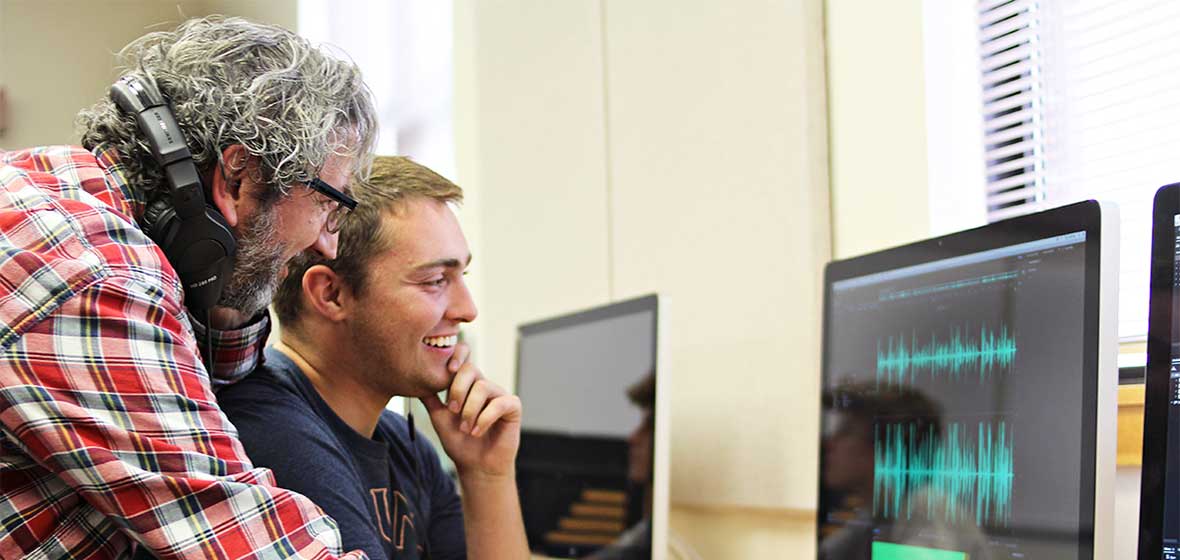It’s never too early to think about finals, especially if your finals are multimedia projects like videos or audio pieces. You might get away with pulling an all-nighter to finish a writing assignment due the next day, but waiting till the last minute for any kind of digital work is a recipe for disaster. Between an audio story for the Reynolds Media Lab, a media history video for Patrick File, or a digital journalism piece for Noticiero Móvil, knowing how to successfully navigate a multimedia final means the difference between a stressed final few weeks and a busy but productive end to the semester. If you have no idea how to navigate digital finals, the Reynolds School has some tips and tricks to help you make the most of your work and time.
Be realistic about your time management.
Kari Barber, who teaches narrative journalism and the documentary class, says it’s important to schedule early and be realistic about how much time tasks like editing and logging take. “I suggest students reach out to an instructor or other students who have been through it for advice about how much time to allot for different tasks.”
Patrick File, who incorporates a final video into his media history class, says time management is the root of the most common mistakes students make. “I structure my assignment with intermediate deadlines throughout the semester so students really can’t wait until the last minute to do it all, but I still think students tend to misjudge how long editing just 60 seconds of audio and video can take.”
If you’re working with a group, or even on your own, map out your project, and set goals and deadlines ahead of the final assignment date. Write out what digital assets you need for each project, and create a calendar plan of when you intend to get them. Give yourself plenty of time, and in the case of long editing nights, bring snacks.
Use Lab 214 and the Reynolds Media Lab
Most of the equipment you’ll need for any digital project is available for you to check out for free at the Reynolds School’s Lab 214. The lab is also full of computers with the editing software you’ll likely need.
Paolo Zialcita, Reynolds School equipment lab manager and student, says don’t wait till the last minute to check out equipment. “Come in with a plan and make sure you know everything you need.”
Luke Sorensen, IT Manager at the Reynolds School, says if you’re checking out equipment on a Thursday, you’re allowed to keep it over the weekend without any penalties. Plus, you can renew over the phone at 775-784-4375. All checked out equipment must be returned the next day, but if you need it for longer, check in with an attendant.
Lab 214 is open Monday through Thursday from 8 a.m. to 9 p.m., Friday from 8 a.m. to 6 p.m. and Sundays from noon to 6 p.m.
Got a question about editing software or need help with your project? The Reynolds Media Lab offers advice and hands-on help to all Reynolds students. There’s also a few extra computers for editing as well. The media lab (RSJ 110) is open Tuesdays and Thursdays from 5 p.m. to 7 p.m., and Fridays from 9 a.m. to 3 p.m. for all Reynolds Students.
If you find yourself in the unfortunate position of finding that the specific piece of equipment you need is checked out, don’t panic. The @One has equipment to check out as well.
Organize and manage your files
You’ve got everything you need, and now you’re ready to put your final project together. You’re in the home stretch, but don’t let your eagerness to be done with the project trip you up at the last minute.
Barber stresses the importance of file organization is crucial towards the end. “People start saving project files with tons of different names, and it becomes a disaster or they don’t save music, photos or other audio to the project folder and lose them in some random place on some random computer.”
Save everything you’ll need in one project folder, and name things appropriately. Be sure to also back up everything you’re working on. “If you wait until the end, assume technology will not work and assume something bad will happen (corrupt files, hard drive broken or stolen, lightning strikes and your computer stops working). I’ve seen all of these,” Barber said.
While you’re at it, practice compressing and exporting files ahead of time to avoid some of that last-minute panic. Barber also suggest exporting versions and uploading them somewhere in case something goes wrong.
Working on multiple digital projects can feel challenging and overwhelming, but there are resources and tips here at the Reynolds School to help you every step of the way. Plan ahead, work hard and use the tools available to you. You got this!












